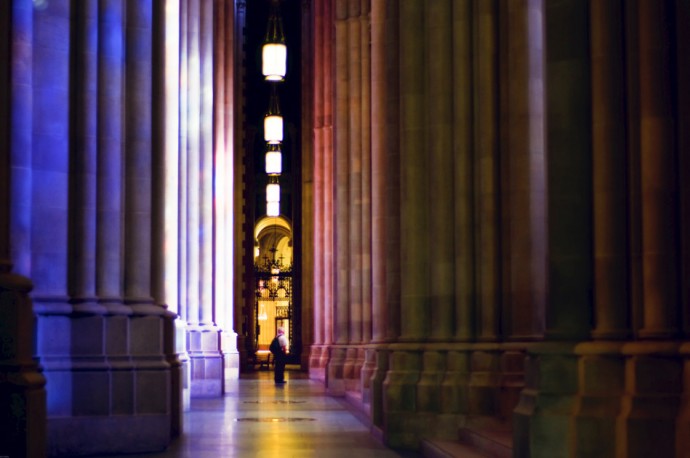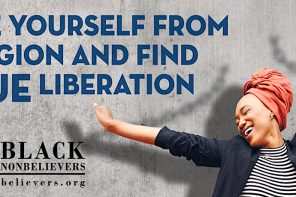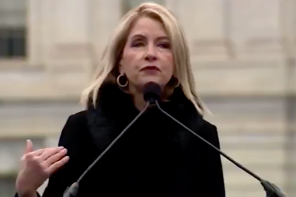I’m a Catholic lapsed and lost, an unaffiliated spiritual seeker. Still, I am drawn to church every year at this time like metal to a magnet. But not just to any church. I am drawn to one of the largest cathedrals in the world, a majestic structure that sits atop one of Manhattan’s highest points, in Morningside Heights. On Good Friday I head from my home in Westchester for the Cathedral of St. John the Divine.
For years now it has been my practice to go there to walk the Stations of the Cross. That means joining an afternoon crowd that grows as we walk, a crowd drawn to the same place and time, men and women, young and old, multi-ethnic, multi-racial, with evident disabilities or hidden ones. We gather in the back of the church in near silence, shoes shuffling on marble, dwarfed by the soaring ceiling and looming stained glass windows. We will make our way through the steps of Jesus’s crucifixion, carrying a big wooden cross, so big it has to be hoisted on the shoulders of four or five people. One year, I helped carry the cross from the third station to the fourth, surprised by the power of that touch—I felt it physically. This year, I only got to reach and touch the cross before the people at the front had to lower it to enter a room, and I lost my grip.
Our path takes us not to simple representations of the Stations of the Cross, but from side altars to the main altar, through the Great Bronze doors to the Seven Chapels of the Tongues, designed to honor the people from countries far and wide who landed on the shores of Ellis Island when it opened in 1892.
At each stop, the minister gathers us together and a volunteer reads about the station—one station in English, the next in Spanish—and then we move on. The text is contemporary, about love and loss, sin and goodness; we pray for the sick and the healers, the powerful and the powerless, the good and the evil, for ourselves. We traverse the hidden corners of the cathedral until we arrive at the last station, number 14, where Jesus is laid in the tomb. From there, we move outside to a garden, where we stand in a circle, the cross gone now, face to face with one another.
I am both in the process and outside of it. I believe in something, but not most of this. I hold on because there is some deep comfort and some essential discomfort here. I can’t let go. Why? What draws me year after year?
I don’t believe in Jesus Christ as God any more—or maybe I believe in him as a little piece of God. But I believe that others were, and are, that little piece of God too. The truth is that for me, the way of the cross symbolizes the deepest challenges of life. Jesus surrenders to his fate, to those who misunderstand him, who can see no other path but to annihilate him. He falls three times under the weight of his terrible burdens. The women who know him weep; Veronica dries his bloodied face; his mother crumbles at his feet. He is stripped and shamed, nailed and hung—a long, agonizing death.
It’s gruesome, this crucifixion at which I’ve chosen to be a modern day witness. We’d like to think it’s out of time. It isn’t; people are still being crucified, which makes me even sadder.
Still, I come. But this year, unlike other years (that year when, hope renewed for a time, I wrote a book celebrating what courageous women were doing to change this punishing, patriarchal church), this year, my faith is gone. I can see a time when this awesome church will be an awesome museum, a monument to beliefs long discredited, as alien to future human beings as the gods of Greek mythology are to us. But this journey, this way of the cross, symbolizes for me all of our travails; the people who support us along the way; the heartache our suffering brings to those who love us; the choice we face to meet violence in kind, or to try for mercy—and most importantly, to me, the wrenching doubt that propels Jesus to cry out in his despair: “Father, why have you forsaken me?”
Whatever Jesus was, God or prophet, I thank him so much for acknowledging the big questions: why are death and suffering entwined in human life? Who would design this? In the end, Jesus resigns himself, commends his spirit to God in faith. Was his faith rewarded? Will ours be? I want to know: how did Jesus really feel when it was over? Was it all worth it? Did he come to life again, not in body (that belief is fast becoming myth even in Christian circles) but in spirit? Will we?
The service finished, I head out of that beautiful garden at the back of the church toward the street, in the rain. But this year I am not ready to go home. This year, as I traveled through the stations, I wanted my mother with me. We used to go to Mass together on Easter Sunday, right up until she died seven years ago.
I feel like my mother is walking with me today, and to return the favor, I decide to go back into the church to light a candle in her memory. I climb the steep stairs to the cathedral and head for the information desk. I’m told it will cost $3 for a candle, an extra $2 if I want a colorful flower decal on it, signifying the cathedral. I go with the decal.
My mother was a headstrong Catholic with her own interpretation of her religion; she took what she wanted and left the rest. She held onto her faith as she raised two children alone after my father died—and after she retired from her clerical jobs she became a painter and a poet.
I head down the aisle toward the first bank of candles. While I’m sure the wall beyond the rack of candles commemorates something meaningful it is too dark to see much and the spot doesn’t draw me. So I keep walking and looking. Then I notice another bank of candles on the other side of the church. A soft light illuminates the wall directly behind the candle rack. A plaque reads: “American Poets Corner.”
I smile. This is perfect.
There are grave-like stones embedded in the floor honoring different American writers, with quotes from each of them. I read, searching for the right words. Then I find them. They belong to Walt Whitman. They say: “I stop somewhere waiting for you.”
Tears come. I know she will want to read, to stay for a while—so I get my mother’s candle a spot in the front row. I set it on fire. I pray to my mom. I thank her. I ask for forgiveness. I tell her I love her. Then I head for home, to await the resurrection.
Photo: “The Little Guy” courtesy flickr user Steven Kelley via Creative Commons






